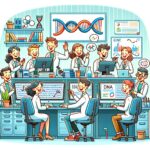
Bioinformatics glossary – W
November 16, 2018A | B | C | D | E | F | G | H | I | J | K | L | M | N | O | P | Q | R | S | T | U | V | W | X | Y | Z
Bioinformatics glossary – W

Weight matrix
The density of binding sites in a gene or sequence can be used to derive a ratio of density for each element in a pattern of interest. The combined individual density ratios of all elements are then collectively used to build a scoring profile known as a weight matrix. This profile can be used to test the prediction of the identification of the selected pattern and the ability of the algorithm to discriminate them from non-pattern sequences.
Western blot
Technique in which specific antibodies are used to identify their antigens from a mixture of proteins. Typically, these proteins mixtures are first separated by electrophoresis and then transfered onto nylon sheets by electrotransfer. Radiolabeled or enzyme-linked antibodies are incubated with the sheets and unbound antibodies washed away allowing the position of the bound antibody to be revealed by autoradiography or color which is formed upon addition of a substrate.
Wild type
Form of a gene or allele that is considered the “standard” or most common.
Web Services
Web Services ( www.w3.org/ws ) are software systems designed to support interoperable machine-to-machine interaction over a network. To ensure that software systems from different sources work well together, they are built using open standards such as SOAP.
Web Services Description Language
Web Services Description Language (WSDL; www.w3.org/TR/wsdl) is a standard method of describing web services and their capabilities. It describes the public interface to the web service, namely the protocol bindings and message formats required to interact with the web services listed in its directory. A client (programme) connecting to a web service can read the WSDL to determine which functions are available on the server. Any special data types used are embedded in the WSDL file in the form of an XML schema. The client can then use SOAP to directly call any of the functions listed in the WSDL.
Whole-genome shotgun
Whole-genome shotgun sequencing describes a procedure used to sequence the genome (or metagenome) which involves the sequencing of small DNA fragments obtained by randomly shearing the total DNA extracted from the sample.
WormBase
Water Program
Water uses the Smith-Waterman algorithm (modified for speed enhancements) to calculate the local alignment.
WEBIN
Interactive system for submitting DNA sequences to EMBL/GenBank/DDBJ.
Webin-Align: Webin-Align. Interactive submission tool for sequence alignments
Western blot
A technique for analysing mixtures of proteins to show the presence, size and abundance of one particular type of protein. Similar to Southern or Northern blotting (see “Blotting”), except that (1) a protein mixture is electrophoresed in an acrylamide gel, and (2) the “probe” is an antibody which recognises the protein of interest, followed by a radioactive secondary probe.
Whichdb
An EMBOSS application. whichdb searches all available EMBOSS databases for sequences with a specified ID name or accession number.
Wild type
Form of a gene or allele that is considered the “standard” or most common.
Wobble
An EMBOSS application. Wobble plots the third position variability as an indicator of a potential coding region.
Wordcount
An EMBOSS application. Displays all the words of the specified length with the number of times it occurs.
Wordmatch
An EMBOSS application. Finds all exact matches of a given minimum size
between 2 sequences displaying the start points in each sequence and the match length.
Wossname
An EMBOSS application. This allows a user to search for keywords or parts of words in the brief documentation (as displayed by a program when it first starts). The program name and the brief description is output. If no words to search for are specified, then details of all the EMBOSS programs are output.
WU-Blast2
WU-Blast2 stands for Washington University Basic Local Alignment Search Tool Version 2.0. It is used to compare a novel sequence with those contained in nucleotide and protein databases by aligning the novel sequence with previously characterised genes. The emphasis of this tool is to find regions of sequence similarity, which will yield functional and evolutionary clues about the structure and function of this novel sequence. Regions of similarity detected via this type of alignment tool can be either local, where the region of similarity is based in 1 location, or global, where regions of
similarity can be detected across otherwise unrelated genetic code. The fundamental unit of BLAST algorithm output is the High-scoring Segment Pair (HSP).
















